These are the best photography of Bangladesh i ever seen .There is no
suitable attribution in this world to make him praise . Many many thanks
Major Rumman Mahmud to represent the real beauty of Bangladesh.
Photography & written by:
Major Rumman Mahmud.
Bangladesh Army.
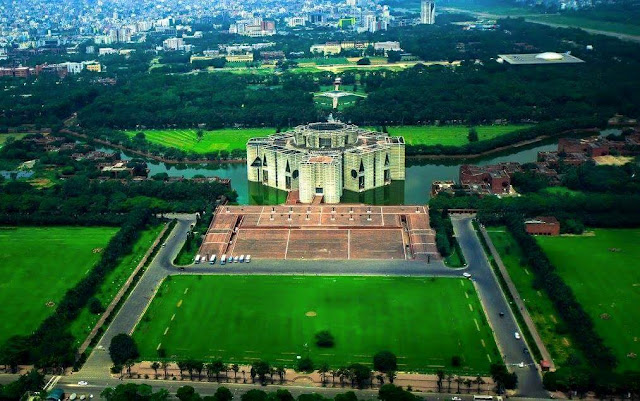
A Hut Which Makes it All.
Jatiyo Sangshad Bhaban or National
Parliament House is the house of the Parliament of Bangladesh designed
by architect Louis Kahn. The complex is one of the largest legislative
complexes in the world, comprising 200 acres (800,000 m²).
Jatiyo
Sangshad was designed by Louis Kahn. Initially, the government had
appointed Muzharul Islam as the center's architect, but Islam deferred,
instead recommending bringing in the world's top architects for the
project. He initially attempted to bring Alvar Aalto and Le Corbusier,
who were both unavailable at the time. Islam then enlisted Louis Kahn,
his former teacher at Yale.
The design of the capital complex was
developed taking into account the aesthetic heritage of Bengal,
particularly including the Ganges delta. Construction began in 1961 as a
permanent building for the federal legislature of both West Pakistan
and East Pakistan and was completed after the country's war of
independence and several decades - on 28 January 1982. The complex
opened the following month on 15 February for the eighth session of the
second parliament of Bangladesh and since has been operating as the sole
complex for the National Assembly.
Louis Kahn designed the entire
complex which includes lawns, lake and residences for the Members of the
Parliament (MPs).The architect’s key design philosophy was to represent
Bangladeshi culture and heritage, while at the same time optimizing the
use of space. The exterior of the building is striking in its
simplicity, with huge walls deeply recessed by porticoes and large
openings of regular geometric shapes. The main building, which is at the
center of the complex, is divided into three parts – the Main Plaza,
South Plaza and Presidential Plaza. An artificial lake surrounds three
sides of the main building extending to the Members of Parliament hostel
complex. This skillful use of water to portray the riverine beauty of
Bangladesh adds to the aesthetic value of the site.
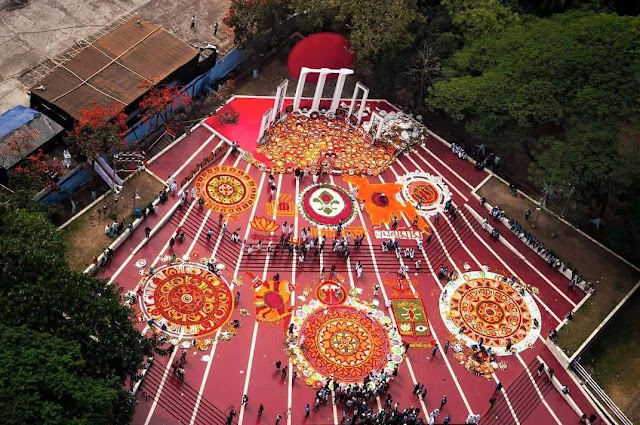
The Journey to Freedom Starts Here.
The Shaheed Minar or the
Martyr Monument is a national monument at Dhaka. It was established to
commemorate those killed during the Bengali Language Movement
demonstrations of 1952.
On 21 February 1952, dozens of students and
political activists were killed when the Pakistani police force opened
fire on Bengali protesters who were demanding equal status for their
native tongue, Bengali. The massacre occurred near Dhaka Medical College
and Ramna Park in Dhaka. A makeshift monument was erected on 23
February by the students of University of Dhaka and other educational
institutions, but soon demolished on 26 February by the Pakistani police
force. The Language Movement gained momentum, and after a long
struggle, Bengali was given equal status with Urdu.
To commemorate
the dead, the Shaheed Minar was designed and built by Hamidur Rahman a
Bangladeshi sculptor in collaboration with Novera Ahmed. The monument
stood until the Bangladesh Liberation War in 1971, when it was
demolished completely during Operation Searchlight. It was rebuilt after
Bangladesh gained independence.
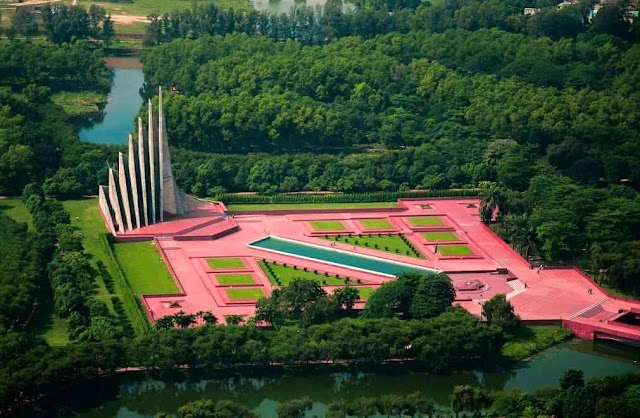
The Indomitable Spirits.
National Mausoleum or the National
Martyrs' Memorial is the national monument of Bangladesh. It is the
symbol in the memory of the velour and the sacrifice of all those who
sacrificed their lives in the Bangladesh Liberation War of 1971. Plans
for the monument were initiated in 1976. Following the site selection,
road and land development, a nationwide design competition was held in
June, 1978. Following evaluation of the 57 submissions, Syed Mainul
Hossain's design was chosen. The main structure and the artificial lake
along with other facilities were completed in 1982. It was inaugurated
on 16 December 1982.
The monument is composed of 7 isosceles
triangular pyramid shaped structures, with the middle one being the
tallest. The highest point of the monument is 150 feet. There is an
artificial lake, and several mass graves in front of the main monument.
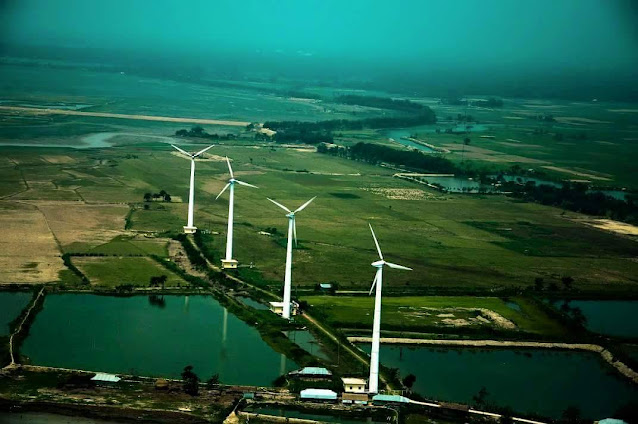
Strength in Rotation.
A very rare find in Bangladesh! The dam
is constructed in 2005 over the river Muhuri at Feni. It has got a large
dam along with 4 wind turbines. The turbines are V27 (27m) and each can
produce 225kW power. Thus the total capacity becomes 900 kW from this
project. It is looked after by Bangladesh Power Development Board.
Lalbagh Fort (also Fort Aurangabad).
It is an incomplete 17th
century Mughal fort complex that stands proudly before the Buriganga
River in the southwestern part of Dhaka. The construction was started in
1678 AD by Mughal Subadar Muhammad Azam Shah who was son of Emperor
Aurangzeb and later emperor himself. His successor, Shaista Khan, did
not continue the work, though he stayed in Dhaka up to 1688.After
Shaista Khan left Dhaka, it lost its popularity. The main cause was that
the capital was moved from Dhaka to Murshidabad. After the end of the
royal Mughal period, the fort became abandoned. In 1844, the area
acquired its name as Lalbagh replacing Aurangabad, and the fort became
Lalbagh Fort.
For long the fort was considered to be a combination
of three buildings (the mosque, the tomb of Bibi Pari and the
Diwan-i-Aam) with two gateways and a portion of the partly damaged
fortification wall. The southern fortification wall has a huge bastion
in the southwestern corner. On the north of the south fortification wall
were the utility buildings, stable, administration block, and its
western part accommodated a beautiful roof-garden with arrangements for
fountains and a water reservoir. The residential part was located on the
east of the west fortification wall, mainly to the south-west of the
mosque.The fortification wall on the south had five bastions at regular
intervals two stories in height, and the western wall had two bastions;
the biggest one is near the main southern gate. The bastions had an
underground tunnel.
The central area of the fort is occupied by
three buildings - the Diwan-i-Aam and the hammam on its east, the Mosque
on the west and the Tomb of Pari Bibi in between the two - in one line,
but not at equal distance. A water channel with fountains at regular
intervals connects the three buildings from east to west and north to
south.
The Knowledge Hub that Grew Old.
The name "Salimullah Muslim
Hall" is related and passed with the University of Dhaka Act. with an
old secretariat building but the new building Salimullah Muslim Hall was
inaugurated on 11 August 1931 as a university hall for the students of
Dhaka University. It is named after Nawab Sir Khwaja Salimullah Bahadur.
Among the residential halls of Dhaka University Salimullah Muslim Hall
holds a special status due to its architectural heritage.
On 27 May
1912, the British government constituted the “Nathan Committee”
establishing a residential hall based university. TheCalcutta University
Commission recommended to establish a Muslim Hall for the Muslim
students of Dhaka University so that the Muslim students can maintain
their own culture and religion. The report of the Nathan Committee and
the recommendation of Calcutta University commission to the government
of India prepared the Dhaka University bill. The bill was passed by the
Indian Law Assembly. The viceroy and governor general Lord Reading
agreed to the bill on 23 March 1920.
Salimullah Muslim Hall, built
in August 1929 as a university hall, this two-storied handsome building
is laid out around an inner courtyard over which its four wings
overlook. Continuous varendahs on the inner facades run in front of rows
of residential rooms. The building faces south and has an arched
entrance in the centre of the south wing which is flanked on either side
by square towers, each crowned with a bulbous dome which is decorated
with yellow glazed tiles. The southern frontage of the building also has
a continuous verandah and subsidiary porches. Its four corners are
provided with square projections which are crowned by triple domes. This
hall, although not much different in plan to other university halls,
but it has a more dignifier appearance because of its perfect symmetry
and fine design.

The Power
The Independent Tower and the Museum is situated at the
historical grounds of Suhrawardy Udyan at Shahabagh, Dhaka. The monument
is the 150 meter long glass tower. The tower is square according to the
plan and is 16 feet wide from every side with an area of 64 acres and
the museum is an underground with multiple attractions built beneath the
tower.
These two establishments commemorate the historical
events that took place in the Suhrawardy Udyan, previously known as
Ramna Race Course ground on the Liberation War of Bangladesh. The
initiative was taken from the government to depict the glorious history
of Independence which came amid a lot of sacrifices. The construction
began back in 1999 when the design was submitted by Kashef Mahboob
Chowdhury and Marina Tabassum. The design came out of a nationwide
competition. However, in two phases, the work was finally completed this
year and the museum was inaugurated on 26 March 2015.
The museum includes a mural works, multi-media projection theater and
amphitheater, a number of walk ways, marble floors, a water body and
other ancillary facilities in addition to the monument. The focal point
in the experience of the space is the monument: a tower of light made of
stacked glass sheets. The area is composed of 67 acres. The main
attraction, the glass tower was built on the place where the
commander-in-chief of East Pakistan Army Amir Abdullah Khan Niazi signed the papers of his surrender.
The underground museum of the project comprises a total of 144
photographs with historical significance. A large photograph of the
historical March 7 speech of Bangabandhu Sheikh Mujibur Rahman is
another attraction of the underground museum. There are a number of
terracotta murals on war-heroes and the events of the Liberation War, a
2000 seat auditorium and an open-air theatre. The eternal flame stands
beside the tower. Films on war and historical videos are shown in the
theatre on important occasions. The water body of the project reflects
the whole tower all the day and increases the beauty of the project,
especially at night.
Royalty in Bricks !
Uttara Gano Bhaban also known as The Maharaja's
Palace or Dighapatia Palace is a historic, formerly royal palace in
Natore, Bangladesh. It was built by the Raja of Dighapatia but is used
as the official residence of the heads of states of Bangladesh in North
Bengal. In the north, it serves as an official Presidential Palace.
Various historic meetings took place at the palace, during the British
Raj, East Pakistan era and finally after the Bangladesh. It is located
about 2.40 km away from the Natore town. Raja Dayaram Roy constructed
the main structure of the palace along with a few wings; but it was Raja
Pramada Nath Roy rebuilt the whole palace complex after the
catastrophic earthquake of 1897.
The Dighapatia Palace was made
'Dighapatia Governor House' on 24 July 1967 by Abdul Monem Khan, the
Governor of erstwhile East Pakistan. Later, after the country's
independence, Bangabandhu Sheikh Mujibur Rahman, President of Bangladesh
declared the Dighapatia Governor House as Uttara Gonobhaban on 09
February 1972. Before the split of Pakistan and Bangladesh, President
Ayub Khan resided at the Palace.
The palace area occupies around 43
acres of land or around 25 bighas, enclosed within a moat and a high
perimeter wall. The estate also contains few lakes and greenery. The
front gate entrance houses an imposing four-storied pyramidal gateway
with a clock tower. It is also contains a series of arched openings on
three stories and two circlets flanking the clock on the top storey.
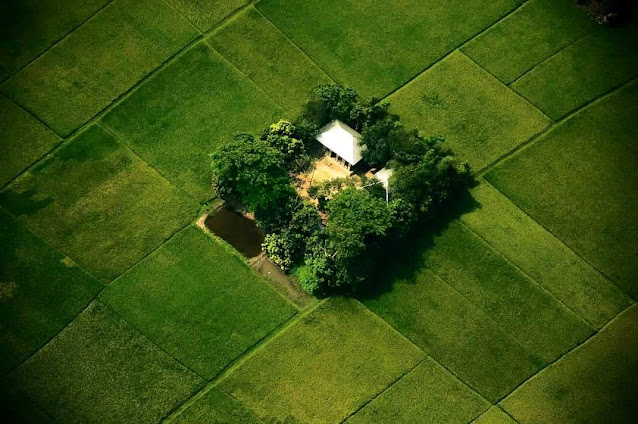
Peace is here !
Peace is here! If you have a little hut along
with a small pond like this in your premises, what else you need to gain
peace. This villager family does not know that how many families will
be craving for such a life like them.
Love and Peace.
It is Bangladesh ! This well maintained and
well planned project is located inside Dhaka Cantonment (beside Mirpur
Flyover). The amazing heart shaped water body refreshes the minds of the
residents of this area even from their balcony. The lake is facilitated
with small boats and a wonderful restaurant.

Celebrating Life.
Pohela Boishakh is the first day of the
Bengali calendar, celebrated on 14 April in the Bangladesh. The Bengali
calendar is tied to the Indian solar calendar, based on the Surya
Siddhanta. Pohela Boishakh is celebrated with grandeur and colours in
Dhaka and other parts of Bangladesh. The celebrations are started at the
break of dawn with a rendition of Rabindranath Tagore’s song “Esho he
Boishakh” by Chhayanat under the banyan tree at Ramna (the Ramna
Batamul). An integral part of the festivities is the Mongol Shobhajatra,
a traditional colourful procession organized by the students of the
Faculty of Fine Arts of Dhaka University. The procession has a different
theme relevant to the country’s culture and politics every year.
Different cultural organizations and bands also perform on this occasion
and fairs celebrating Bengali culture are organized throughout the
country.
People from the small and serene town of Jessore woke up
early morning on the first day of Boishakh of 1392 Bengali year (14
April 1985) to the beats of Bengali drums. Their surprise changed to
wonder when they saw 400 colourfully attired people, mostly children,
dancing to the beats of drums and other Bengali folk musical
instruments. The precisionists paraded through the town wearing
colourful crowns, bearing colourful masks of animals. People, who
witnessed the procession, witnessed history, the history of a colourful
procession - Mongol Shovajatra - at the dawn of Pohela Boishakh.
Some years later, Dhaka Fine Arts Institute brought out a similar
procession in 1989, the brainchild of three youths: Mahabub Jamal
Shamim, Moklesur Rahman and Heronmay Chanda who were the pioneers of the
Jessore procession. Soon the colourful Mongol Shobhajatra spread
countrywide and became an integral part of Bengali culture. And thus the
Mongol Shobhajatra became a national phenomenon.
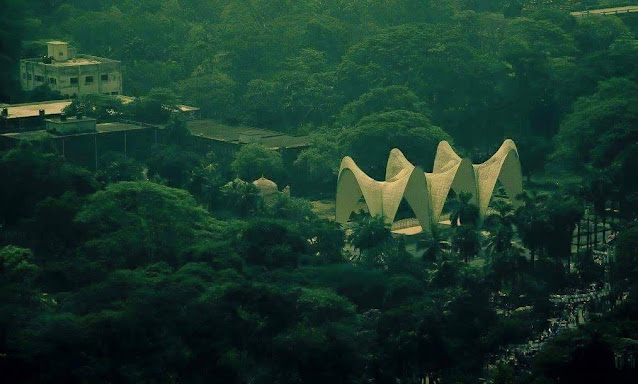
Respect.
The Mausoleum of three leaders is a significant
architectural monument located at Shahbag, Dhaka. The monument hosts the
graves of three pre-liberation Bengali politicians in the 20th century-
A.K. Fazlul Huq (1873–1962), Huseyn Shaheed Suhrawardy (1892–1963) and
Khwaja Nazimuddin (1894–1964). All three men served as the Prime
Minister of Bengal in British India.The Mausoleum was designed by
architect Masood Ahmed and S.A. Zahiruddin and was established in the
year 1963. The style of architecture of the monuments is an
interpretation of Islamic Arcs.
The Mausoleum of three leaders
consists of a hyperbolic paraboloid structure that is erected over the
three graves of the three political leaders. The three leaders had died
in separate dates but were all buried in the same area as all three of
them had contributed significantly to East Pakistan and were all
involved politically. A.K. Fazlul Huq was a very well known politician
who was famous for his leadership qualities. One of his most important
contributions was being involved with the Bengali Language Movement.
Fazlul Huq along with Huseyn Suhrawardy had engaged in many political
acts such as forming the United Front in the 1954 elections, with which
they had gained victory by winning the most seats. Huseyn Suhrawardy and
Fazlul Huq had also worked together to control the government of East
Pakistan. Suhrawardy was known to be the founder of the Bangladesh Awami
League. He was also known to contribute significantly to the growth and
development of East Pakistan. Suhrawardy became the Prime Minister of
Pakistan in 1956 but was forced to resign in 1957. He was completely
banned from politics by Ayub Khan (President of Pakistan). Khawaja
Nazimuddin was the Prime Minister of Pakistan from 1951 to 1953.
Suhrawardy had served as the Minister of Labor and also the Minister of
Civil Supplies under Khawaja Nazimuddin. At that time, Pakistan was
considered to be moving in a forward direction in terms of turning into a
republic but it soon failed as Nazimuddin had died shortly after in the
year 1963.
Royalty in Bricks.!
Ahsan Manzil was the official presidential
palace and seat of the Dhaka Nawab Family. This magnificent building is
situated at Kumartoli along the banks of the Buriganga River at Dhaka.
The construction of this palace was started in 1859 and was completed in
1872.It was constructed in the Indo-Saracen Revival architecture. It
has been designated as a national museum.
The building structure was
established on a raised platform of 1 meter, the two-storied palace
measures 125.4m by 28.75m. The height of the ground floor is 5 meters
and the height of the first floor is 5.8 meters. The thickness of the
walls of the palace is about 0.78 meters. There are porticos of 5 meters
height on the northern and southern sides of the palace. There was once
a fountain in the garden in front of the stairs which does not exist
today. All along the north and the south side of the building run
spacious verandahs with an open terrace projected in the middle.
The
palace Ahsan Manzil is divided into two parts: the eastern side and the
western side. The eastern building with the dome is called the
Rangmahal and the western side with the living rooms is called
Andarmahal. The high octagonal dome is placed on the central round room.
There is a large drawing room, card room, library, state room and two
other guest rooms are located on the east side of the palace. The
ballroom, the Hindustani room and few residential rooms are situated on
the western side. A beautiful vaulted artificial ceiling, made of wood,
decorates the drawing room and the Jalsaghar. A splendid dining hall and
few smaller rooms are placed on the west part. The floors of the dining
and Darbar Halls are decorated with white, green and yellow colored
ceramic tiles. Along with those rooms a Darbar Hall or assembly hall and
a chest room is also place there.

Mosaic in Green
“Mosaic in green.” The caption is a borrowed
one. Did not find anything better. If you are lucky to see Bangladesh
from above (especially in rainy season) you would find the whole
Bangladesh is a mosaic in green. You will be amazed seeing the art of
paddy fields all around the country which are made unintentionally.
When Life and Death Collide
Here is the togetherness of life and
death! Bangladesh is a land of green. Anywhere you find a piece of land,
will find it cultivated. Beside this, you will find this type of
collation of brick fields and paddy fields. One infuses life and another
destroys!

The Heritage
Sadarghat River Front, on the river Buriganga, is one
of the most dynamic places in Dhaka. Here, the Sadarghat Launch Terminal
is one of the largest river ports in the world. About 200 large and
small passenger launches depart and arrive at the terminal every day.
According to the officials at the terminal, 30,000 people, in average,
use the terminal for departure and arrival every day. Visiting this
place is a pandemonium; you may see what you can never experience in
this world.
The River Buriganga, though smelly and muddy, is the
lifeblood of Old Dhaka. It’s fascinating to watch the large river
ferries, over laden with people and local produce, and the loading and
unloading activities to ramshackle warehouses on the riverfront.
Triple-decked ferries are docked along the side of the jetty while small
wooden boats pile their trade in between. The shrill of sirens sound
like an air raid as boats depart and arrive from the countryside.
A
constant stream of humanity flows up gangplanks and on to ferries
moored tightly together along rusting pontoons. Ship’s bells and
klaxons, the cries of porters, vendors and beggars, the muezzins
announcing evening prayer – it is a cauldron of noise. It’s seems
chaotic, but its one step in a well-organized supply chain across the
country, dating back many centuries.
It’s really interesting to see
the huge ferries. There’s a small charge to enter the dock, but most
boats will let you aboard for nothing. A trip on a ferry or the Rocket
Steamer (paddle steamer) departing Dhaka to Mongla via Khulna is without
doubt the best thing u could do in this city.
Busy, noisy, and
muddy Sadarghat may apparently seem not friendly for tourists but not
seeing it is like not tasting a real Dhaka at all. It is the heart of
Old Dhaka and is like essence of it. Stays busy all day long, full of
any kind of bouts and people. That is so authentic – just a true face of
Dhaka’s everyday life. You may love it or hate it but it will not
remain you indifferent and you will never forget it. Great place for
those Nikon moments!

Jahangir Nagar University,Dhaka




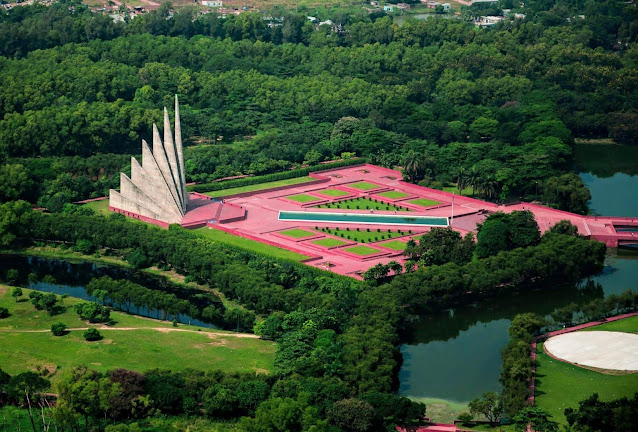






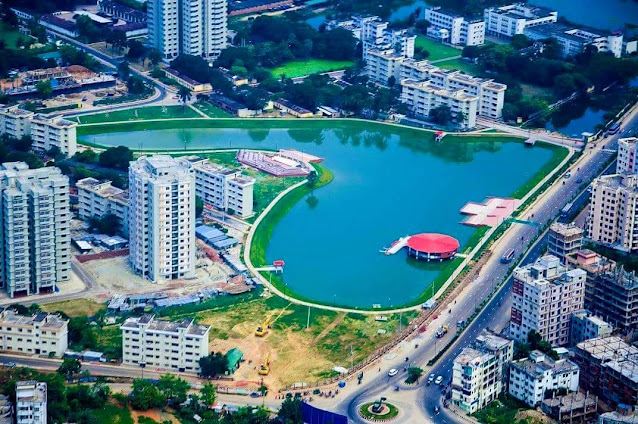




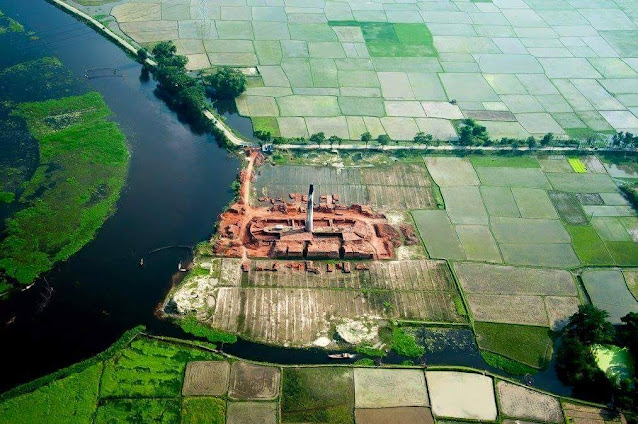


Comments
Post a Comment
If you have any doubts, Please let me know